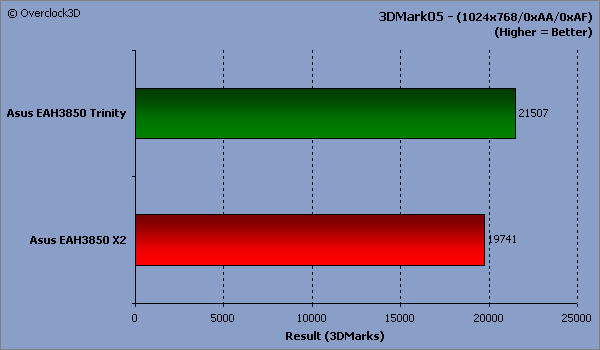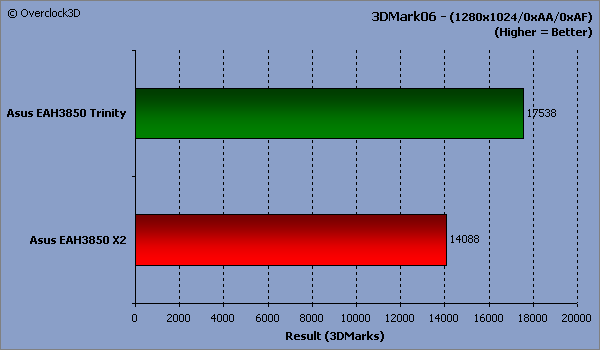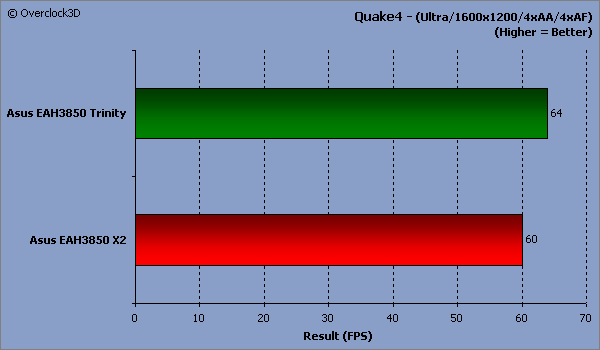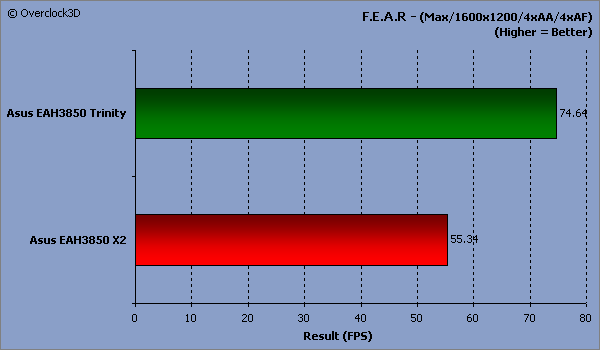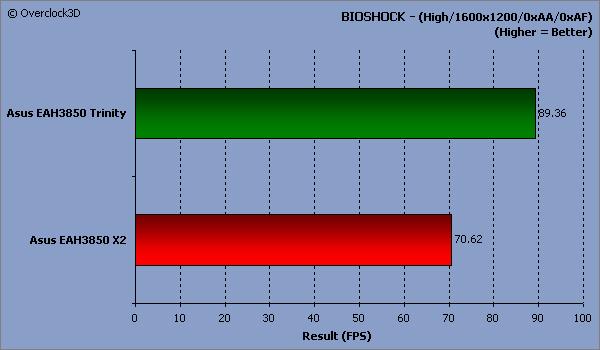Published: April 27, 2008 |
Source:
Asus |
Author:
James Napier
Asus EAH3850 Trinity
Test Setup
Â
To ensure that all reviews on Overclock3D are fair, consistent and unbiased, a standard set of hardware and software is used whenever possible during the comparative testing of two or more products. The configuration used in this review can be seen below:
Â
Processor• Intel Core 2 Quad Q6600 “G0” 2.4GHz 2x 4MB @ 3.16ghz
Motherboard
• Asus Rampage Formula X48 DDR2
Cooling
• OCZ Vendetta 2 + Stock Fan
Memory
• Cellshock PC2-6400 DDR2 2GB Kit (5-4-4-15)
Graphics Card(s)
• Asus EAH3850 “Trinity”
• Asus EAH3850 X2
Hard Disk
• Hitachi Deskstar 80GB 7K80 SATA2 7200RPM 8mb
Operating System
• Microsoft Windows Vista Ultimate (Latest Updates)
Â
After experiencing problems with fitting the Trinity inside an Antec Nine Hundred along with several cases of Vista misbehaving, a DVD-RW deciding that it didn’t like our Call Of Duty 4 disk and a hard disk failure, our initial plans to run a selection of four games at various resolutions pretty much went out of the window. In the end we had to settle for the following benchmarks:
Â
3D Benchmarks• 3DMark05
@ Default Settings• 3DMark06
@ Default Settings
3D Games
• Quake 4 @ 1600×1200 / 4xAA / 4xAF / Ultra Settings
• Bioshock @ 1600×1200 / Highest Settings
• F.E.A.R @ 1600×1200 / 4xFSAA / Maximum Settings
Â
Â
Â
3DMark is a popular synthetic gaming benchmark used by many gamers and overclockers to gauge the performance of their PC’s. All 3DMark runs were performed a total of 5 times with the highest and lowest results being removed and an average calculated from the remaining 3 results.
Â
Â
Â
Â
Â
Quake 4 is a game built on the Doom 3 engine. Benchmarking was performed using Quake4Bench and a custom timedemo recording along with 4xAA, 4xAF settings at a resolution of 1600×1200 for maximum stress on the GPU. The benchmark was set to run a total of 5 times, with Quake4Bench automatically calculating an average result at the end of the run.
Â
Â
Â
Â
F.E.A.R. is a game based on the Lithtech Jupiter EX engine. It has volumetric lighting, soft shadows, parallax mapping and particle effects. Included in the game is a benchmark facility that taxes the entire PC system. This benchmark was run a total of 5 times, with the highest and lowest results being excluded and an average being calculated on the remaining 3 results.
Â
Â
Â
Â
Bioshock is a recent FPS shooter by 2K games. Based on the UT3 engine it has a large amount of advanced DirectX techniques including excellent water rendering and superb lighting and smoke techniques. All results were recorded using F.R.A.P.S with a total of 5 identical runs through the same area of the game. The highest and lowest results were then removed, with an average being calculated from the remaining 3 results.
Â
Â
Â
Result Observations
Â
While we would have ideally liked the place the Trinity against several other cards, performing a head-to-head comparison with the Asus 3850X2 gives us a clear indication of just how much use games are able to make out of that third GPU. As we can see from the graphs above, the Trinity pretty much slaughters the 3850X2, taking a 27% lead in BIOSHOCK and an almost unbelievable (but thoroughly re-producible) 34% increase in F.E.A.R. Quake 4 on the other hand, didn’t seem to take much advantage of the extra GPU/memory and only showed a 4FPS increase.





